King cake
A king cake (sometimes referred to as kingcake, kings' cake, king's cake, or three kings' cake) is a type of cake associated in a number of countries with the festival of Epiphany at the end of the Christmas season; in other places, it is associated with the pre-Lenten celebrations of Mardi Gras/Carnival.
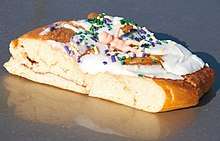 Part of a Louisiana-style king cake with the plastic baby figurine on top | |
| Alternative names |
|
|---|---|
| Type | Cake |
| Similar dishes | |
What started out roughly 300 years ago as a dry French bread–type dough with sugar on top and a bean inside now comes in many varieties depending on the country. Some king cakes are made of a sweet brioche dough in the shape of a hollow circle with a glazed topping sprinkled with colored sugar. Hundreds of thousands of king cakes are eaten in New Orleans during the Carnival season. In other countries, king cakes are made with a puff pastry, filled with one of several fillings (e.g., almond, apple, chocolate/pear, etc.), and have a small figurine, called a fève, hidden inside. The figurine changes from bakery to bakery and can have a variety of themes. The person who gets the piece of cake with the fève has various privileges and obligations.[1][2]
History
The "king cake" takes its name from the biblical Kings. In Western Christian liturgical tradition, the Solemnity of Epiphany—commemorated on January 6—celebrates the visit of the Magi to the Christ Child. The Eve of Epiphany (the night of January 5) is popularly known as Twelfth Night (the Twelve Days of Christmas are counted from Christmas Eve until this night). The season for king cake extends from the end of the Twelve Days of Christmas (Twelfth Night and Epiphany Day), up until the end of Shrovetide: Mardi Gras, "Fat Tuesday," or Shrove Tuesday; the day before the start of Lent. Some organizations or groups of friends may have "king cake parties" every week through the Carnival season. In Portugal and France, whoever gets the King cake trinket is expected to buy the next cake for these get-togethers.
It is a popular food item during the Christmas season (Christmas Eve to Epiphany) in Belgium, France, Quebec and Switzerland (galette or gâteau des Rois or galette des rois), Portugal (bolo rei), Spain and Latin America (roscón or rosca de reyes), and Greece and Cyprus (vasilopita) and Bulgaria (banitsa).
In the United States, Carnival is traditionally observed in the Southeastern region of the country, particularly in New Orleans, Bay Saint Louis, Mobile, Pensacola, Galveston, and other towns and cities of the Mississippi Gulf Coast. In these regions, the king cake is closely associated with Mardi Gras traditions and is served throughout the Carnival season, which lasts from Epiphany Eve to Fat Tuesday.[3] The King Cake tradition is thought to have been brought to New Orleans from France in 1870.[4] Now, as part of the celebration, it is traditional to bake a cake (King Cake) in honor of the three kings. The official colors of Mardi Gras—created in 1872 by the Krewe of Rex—are purple for justice, green for faith, and gold for power.[3]
Related culinary traditions are the tortell of Catalonia, the gâteau des Rois or reiaume in Provence or the galette des Rois in the northern half of France, bolo rei of Portugal, and the Greek and Cypriot vasilopita. The galette des Rois is made with puff pastry and frangipane (while the gâteau des Rois is made with brioche and candied fruits). A little bean was traditionally hidden in it, a custom taken from the Saturnalia in the Roman Empire: the one who stumbled upon the bean was called "king of the feast." In the galette des Rois, since 1870 the beans have been replaced first by porcelain and now by plastic figurines.
Now replaced by the Christmas cake, a similar tradition was also followed in the United Kingdom.
Regional variants
France and Catalonia

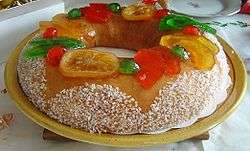
The cake traditionally celebrating Epiphany in France and Quebec is sold in most bakeries during the month of January. Three versions exist: in northern France, Quebec, and Belgium the cake called galette des rois in French or Koningentaart in Flemish/Dutch (which can be either circular or rectangular) consists of flaky puff pastry layers with a dense center of frangipane or apple. In the west of France a sablé galette is made, a form of sweetcrust pastry. In southern France—Occitania, Roussillon, Provence (as well as in Catalan where it is called tortell)—the cake called gâteau des rois or royaume is a torus-shaped brioche with candied fruits and sugar, similar in its shape and colors to a crown. This later version is also common in Spain and very similar to the New Orleans king cake.
Tradition holds that the cake is "to draw the kings" to the Epiphany. A figurine, la fève, which can represent anything from a car to a cartoon character, is hidden in the cake, and the person who finds the trinket in his or her slice becomes king for the day and will have to offer the next cake. Originally, la fève was literally a broad bean (fève), but it was replaced in 1870 by a variety of figurines made out of porcelain or—more recently—plastic.[5] These figurines have become popular collectibles and can often be bought separately. Individual bakeries may offer a specialized line of fèves depicting diverse themes from great works of art to classic movie stars and popular cartoon characters. The cakes are usually sold in special bags, some of which can be used to heat the cake in a microwave oven without ruining the crispness of the cake. A paper crown is included with the cake to crown the "king" who finds the fève in their piece of cake. To ensure a random distribution of the cake shares, it is traditional for the youngest person to place themselves under the table and name the recipient of the share which is indicated by the person in charge of the service.
Formerly, the cake was divided into as many shares as there were guests, plus one. The latter, called "the share of God," "share of the Virgin Mary," or "share of the poor" was intended for the first poor person to arrive at the home.[6]
Portugal
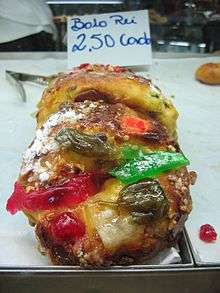 | |
| Type | Cake |
|---|---|
| Place of origin | Portugal |
| Main ingredients | Flour, eggs, butter, dried fruit, nuts, candied fruit |
Bolo-rei, (lit. 'king cake') is a traditional Portuguese cake that is usually eaten around Christmas, from December 25 until Epiphany (Dia de Reis in Portuguese, literally "Kings' Day," a reference to the Three Wise Men), on 6 January. It is a staple holiday dessert in any Portuguese home.[7]
The bolo-rei recipe was derived from the French Gâteau des Rois which found its way to Portugal during the 19th century when Confeitaria Nacional[8] opened as Portuguese monarchy's official bakery in 1829. The Confeitaria was the first to introduce this recipe to the country.[9]
The cake itself is round with a large hole in the centre,[10] resembling a crown covered with crystallized and dried fruit.
The bolo-rei is baked from a soft, white dough, with raisins, various nuts and crystallized fruit. Also included is the characteristic dried fava bean, and tradition dictates that whoever finds the fava has to pay for the Bolo-rei next year.[11] A small prize (usually a small metal toy) was also included within the cake. The inclusion of the prize has been discontinued since the mid-90s, due to potential choking hazards.[12]
In 2009, a giant bolo-rei measuring about 70 metres (230 ft) and weighing around 200 kilograms (440 lb) was baked for the town of Olhão by pastry chef Filipe Martins of Pastelaria Kubidoce.[13]
Spanish-speaking countries
 Majorcan roscón | |
| Alternative names | Rosca de reyes |
|---|---|
| Course | Dessert |
| Place of origin | Spain |


The roscón de reyes (ring of the kings) in Spain or rosca de reyes in Latin America is traditionally eaten on January 6, during the celebration of the Día de los reyes magos (Epiphany or the "Day of the Three Wisemen"). Originally from Spain it is more commonly associated[14][15] and celebrated in Mexico[14] and Mexican diaspora throughout the world, as well as throughout the Hispanic world. Recipes vary from country to country and between cultures. In most of Spain, Mexico and in Latino communities in the United States, this is the day when children get presents from the Three Wise Men. Before going to bed, children in Mexico and other Latin American countries, such as Argentina, leave a shoe outside their home or room, filled with hay or dried grass and a bowl of water as a present for the animals the reyes ride, along with a note for the reyes. The roscón de reyes has an oval shape to symbolize a crown. For decoration, people sometimes use dried and candied fruits such as figs, quince or cherries. The fruit symbolizes the many jewels that a crown would have.
The tradition of placing a bean, candy or figurine of the baby Jesus inside the cake is followed. The figurine of the baby Jesus hidden in the bread represents the flight of the Holy Family, fleeing from King Herod's Massacre of the Innocents. Whoever finds the baby Jesus figurine is blessed and must take the figurine to the nearest church on February 2 (Candlemas Day, Día de la Candelaria), which celebrates the presentation of Jesus in the Temple[16]. In Mexican culture, the tradition has a long list of traditions that vary based on region and family, as well as moving away from Mexico, and centers even more around sharing food and generosity with neighbors. The person who finds the baby Jesus has the responsibility of hosting a dinner and providing tamales and atole—traditional Christmas foods, (but which are highly labor intensive) to the guests. This celebration will often includes Pozole, (a hearty warming stew for cold weather and mornings) which is made for all of one's neighbors. Other observations state that the person who finds the baby Jesus is the "comadre" or "compadre" (guardian) of Jesus for that year. In Mexico and the Mexican diaspora in the United States, people who find the baby Jesus figurine in their piece of cake usually agree to host a party on Candlemas (February 2) and to provide the guests with tamales and atole.[17]
In Argentina, the tradition of consuming a rosca on January 6 is also followed, although no figurine is included. In addition, a similar version with whole cooked eggs on top of the cake is also served on Easter as rosca de Pascua.
In some places, the rosca de reyes is replaced by panettone.[18]
Roscón de reyes generally has an oval shape due to the need to make cakes large enough for large groups. For decoration, figs, quinces, cherries, or dried and candied fruits are often, but not exclusively, used.[15] It may be compared to a King Cake but is a distinct tradition from King Cake, in that it emerged from Hispanic culture and Latin America's unique observance of the holiday, but is similar to others in that it emerges from a Catholic observance of food, celebration, and reverence for the holidays.[19]
In Galicia and Argentina, a similar version of the pastry with whole eggs baked on top is served on Easter as rosca de Pascua.
U.S. Gulf Coast
In the southern United States, the tradition was brought to the area by Basque settlers in 1718.[20] Originally, it was a cinnamon-filled bready cake eaten to celebrate Epiphany, but it is now associated with Carnival (also known as Mardi Gras). Celebrated across the Gulf Coast region from the Florida Panhandle to East Texas, King cake parties are documented back to the 18th century.
The king cake of the Louisiana tradition comes in a number of styles. The most simple, said to be the most traditional, is a ring of twisted cinnamon roll-style dough. It may be topped with icing or sugar, which may be colored to show the traditional Mardi Gras colors of green, yellow, and purple. King cakes may also be filled with additional fillings, the most common being cream cheese, praline, cinnamon, or strawberry. A so-called "Zulu King Cake" has chocolate icing with a coconut filling, because the Krewe of Zulu parade's most celebrated throw is a coconut.[21] Some bakers now offer king cakes for other holidays that immediately surround the Mardi Gras season, such as king cakes with green and red icing for Christmas, cakes with pink and red icing for Valentine's Day, and cakes with green and white icing for St. Patrick's Day. Others have gone a step further and produce specialty king cakes from the beginning of football season for Louisiana State University and New Orleans Saints tailgate parties, then for Halloween, then Thanksgiving—and do not cease until after Mardi Gras season, when they produce an Easter holiday king cake.
In the Southern culture, whoever finds the trinket must provide the next king cake or host the next Mardi Gras party.[21][22]
New Orleans
Starting on Epiphany on January 6, residents begin holding parties especially dedicated to King Cake. King Cake parties bring families and community members together to celebrate the season of Mardi Gras, with its krewe parades and festivals. King Cake is symbolic of the Mardi Gras celebration for residents it is believed that consuming King Cake outside of the Carnival season will result in rain on Mardi Gras day.[23] The dessert's "search for the baby," the small figurine located inside the cake, is a fun way for residents of New Orleans to celebrate their Christian faith.[24]
The dessert's significance to the city was evident in the first Mardi Gras season (2006) after Hurricane Katrina: people placed thousands of King Cake orders to bakeries as displaced New Orleanians craved connection with tradition and wanted to share their Carnival culture.[25] Whomever finds the baby brings the next year's king cake. Many local schools have weekly king cakes during the season, and the student that finds the baby brings the king cake the next week.
King Cakes can be found all over the city during the season. Locals are loyal to their favorite king cake bakery. Some of the oldest ones include Randazzo's[26] and McKenzie's.[27] If you don't live in the area many companies will ship across the country.
Some sports teams around the area have also infused the tradition of the king cake baby into their teams. The Miami Marlins AAA minor league baseball affiliate, formerly known as the New Orleans Zephyrs, changed their name to the New Orleans Baby Cakes, starting in the 2017 season. The New Orleans Pelicans introduced the King Cake Baby as a second mascot during games around Mardi Gras, to accompany their main mascot, Pelican Pierre.
United Kingdom
A King cake – normally referred to as a "Twelfth Cake", "Twelfth-night cake", or "Twelfth-tide cake"[28] – was once popular in the United Kingdom on Twelfth Night. It was frequently baked with a bean hidden in one side and a pea hidden in the other; the man finding the bean became King for the night, while the lady finding the pea became the Queen[29] - also known as the Lord or Lady of Misrule.[30] Earlier, in the time of Shakespeare, there was only a Lord of Misrule, chosen by the hidden bean, reflected in Shakespeare's play Twelfth Night[31]
Samuel Pepys recorded a party in London on Epiphany night, 6 January 1659/1660, and described the role the cake played in the choosing of a "King" and "Queen" for the occasion: "...to my cousin Stradwick, where, after a good supper, there being there my father, mothers, brothers, and sister, my cousin Scott and his wife, Mr. Drawwater and his wife, and her brother, Mr. Stradwick, we had a brave cake brought us, and in the choosing, Pall was Queen and Mr. Stradwick was King. After that my wife and I bid adieu and came home, it being still a great frost."[32]
Although still occasionally found in the United Kingdom, as the Industrial Revolution curtailed the celebration of the 12 days of Christmas during the Victorian era,[33] the cake declined in popularity to be replaced by the Christmas cake. 18th century actor Robert Baddeley's will bequeathed £3 per annum to serve wine, punch and a Twelfth Night cake to the performers of the Drury Lane Theatre in the green room each Twelfth Night; the ceremony of the "Baddeley Cake" has remained a regular event, missed only 13 times in over 200 years, during wartimes or theatre closures.[34]
Trinket
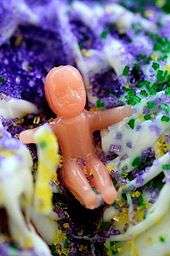
Traditionally, a small plastic or porcelain baby[35] is hidden in the king cake. Originally, the baby was placed in the cake to symbolize baby Jesus. Fava beans were also used to represent Jesus.
Today, the baby symbolizes luck and prosperity to whoever finds it in their slice of cake. That person is also responsible for purchasing next year's cake,[36] or for throwing the next Mardi Gras party. In some traditions, the finder of the baby is designated "king" or "queen" for the evening. This is very popular among kids.
As beans and porcelain figures became replaced with plastic babies, many bakers have recently been placing the baby outside of the cake, and leaving the hiding to the customer. This is also because there is a potential of customers choking on or swallowing the baby, and bakers want to stay clear of this liability.[37]
Ingredients and recipes
There are many different recipes for king cake. However, the most common ones include: milk, butter, yeast, water, brown and white sugar, eggs, salt, nutmeg, flour and cinnamon. The frosting is typically made from confectioner's sugar, water, lemon juice, and colored sugar crystals.[38]
The colors of the king cake originally came from the Christian religion. The purple symbolizes justice, the green symbolizes faith, and the gold symbolizes power. The three colors honor the three kings who visited the Christ child (Jesus) on Epiphany, the 12th day after Christmas.[3]
Gallery
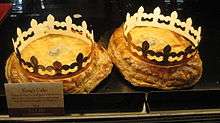 French Galette des Rois with cardboard "crowns"
French Galette des Rois with cardboard "crowns" Gâteau des Rois (Kings' Cake) in Marseille, France
Gâteau des Rois (Kings' Cake) in Marseille, France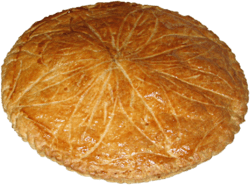 Galette des Rois (Kings' Cake) in Paris, France
Galette des Rois (Kings' Cake) in Paris, France Galette des Rois
Galette des Rois- Kings' Cake (βασιλόπιτα) of Greece
 King and bean from inside a Spanish Roscón de Reyes
King and bean from inside a Spanish Roscón de Reyes Kings’ Cake sculpture in Spain
Kings’ Cake sculpture in Spain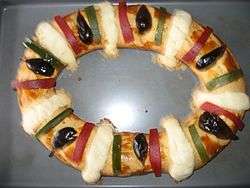 Rosca de reyes in Mexico
Rosca de reyes in Mexico- Kringle from Scandinavia
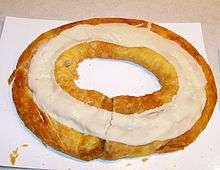 Kringle from Racine, Wisconsin
Kringle from Racine, Wisconsin- Dreikönigskuchen in Switzerland
- Bolo Rei of Portugal
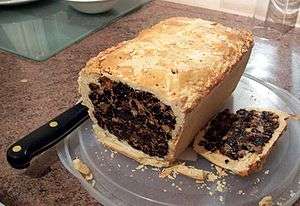 Black bun of Scotland
Black bun of Scotland Rosca de reyes of Spain
Rosca de reyes of Spain
See also
- Barmbrack
- Black bun
- Bolo Rei
- Galette
- Kringle
- Manny Randazzo King Cakes
- Panettone
- Rosca de reyes
- Vasilopita
References
- "History of King Cakes". New Orleans Showcase.
- Eliza Barclay: Is That a Plastic Baby Jesus in My Cake, National Public Radio from 2012-2-17(englisch)
- Layla Eplett (2014-03-04). "Three Men and a Baby: A Brief History of King Cakes". Scientific American, Blog Network.
- "Randazzo's Camellia City Bakery". Retrieved 27 February 2017.
- Papadopoulos, Madina. "A Short History of King Cake's Long History". pastemagazine.com. Retrieved 23 August 2017.
- "La Galette des Rois: the French King Cake". frenchfoodintheus.org. Retrieved 23 August 2017.
- A Portuguese Christmas Retrieved 12 August 2013
- Bolo-Rei: The King of Portuguese Christmas Cakes Retrieved 12 August 2013
- The Battle for Lisbon’s best pastry Retrieved 12 August 2013
- A Foodie’s Guide to Christmas in Europe Retrieved 12 August 2013
- Bolo Rei Portuguese Kings Cake – A treat for your Christmas table recipe Retrieved 12 August 2013
- ASAE - Portuguese Authority on Food Safety and Economy
- Giant Bolo Rei offered to the people of Olhão Archived November 13, 2013, at the Wayback Machine Retrieved 12 August 2013
- mexgrocer (2019-12-13). "Rosca de Reyes is a Mexican Tradition". MexGrocer.com Blog. Retrieved 2020-01-09.
- "Rosca de Reyes Recipe (Kings Day Bread)". My Latina Table. 2019-01-04. Retrieved 2020-01-09.
- According to the Jewish tradition, a firstborn male infant was to be presented to God in the Temple forty days after his birth to be redeemed from serving as a Temple priest (Leviticus 12, Exodus 13:12–15, see Pidyon HaBen). The name Candlemas is derived from the use of candles on liturgical observances, representing the light of Christ presented to the world (John 1:9).
- "Happy Candlemas! ¡Feliz Día de la Candelaria!". CancunSafe. NeuMedia. Retrieved 2 March 2011.
- Ingrid Hoffmann. "Three Kings Bread: Rosca de Reyes". Food Network.
- JPC-DESIGN, whychristmas?com /. "Epiphany, the Feast of The Three Kings on whychristmas?com". www.whychristmas.com. Retrieved 2020-01-09.
- Byrn, Anne (2016). American Cake: From colonial gingerbread to classic layer, the stories and recipes behind more than 125 of our best-loved cakes. p. 18. ISBN 9781623365431. OCLC 934884678.
- Stanonis, Anthony J.; Wallace, Rachel (2018). "Tasting New Orleans: How the Mardi Gras King Cake Came to Represent the Crescent City". Southern Cultures. 24 (4): 6–23. doi:10.1353/scu.2018.0043.
- Gaudet, Marcia (2003). "The New Orleans King Cake in Southwest Louisiana". In Gaudet, Marcia; McDonald, James C. (eds.). Mardi Gras, Gumbo, and Zydeco: Readings in Louisiana Culture. Jackson, MS: University Press of Mississippi. pp. 48–57. ISBN 1-57806-529-1.
- "How to Celebrate Twelfth Night in New Orleans". Retrieved 2017-01-07.
- "History". King Cake.
- "King Cake Tradition, King Cake for Mardi Gras". Mardi Gras Day. Retrieved 2016-01-07.
- "Randazzo's Camellia City Bakery | New Orleans King Cake Shipping & Bakery". Randazzo's Camellia City Bakery. Retrieved 2020-02-24.
- "McKenzie's Food Store". mckenziesfoodstore.business.site. Retrieved 2020-02-24.
- Oxford English Dictionary, 1st edition, 1916, s.v.
- Macclain, Alexia (4 January 2013). "Twelfth Night Traditions: A Cake, a Bean, and a King -". Smithsonian Libraries. Retrieved 10 January 2018.
According to the 1923 Dennison's Christmas Book, "there should be a King and a Queen, chosen by cutting a cake…" The Twelfth Night Cake has a bean and a pea baked into it. The man who finds the bean in his slice of cake becomes King for the night while the lady who finds a pea in her slice of cake becomes Queen for the night.
- Lawrence, Anne (December 9, 2016). "Christmas 2016: Twelfth Cake". Reading History. Retrieved 10 January 2018.
- Dobson, Michael (15 March 2016). "Festivity, dressing up and misrule in Twelfth Night". British Library. Retrieved 10 January 2018.
- Diary of Samuel Pepys
- Baldock, James (26 Dec 2016). "Sea swimming, wassailing and minced lamb – 11 fun things you can do between Boxing Day and Twelfth Night". Metro. Retrieved 10 January 2018.
- Ewbank, Anne (5 January 2019). "How £100 Bought an Obscure British Actor 224 Years of Cake and Fame". Gastro Obscura. Atlas Obscura. Retrieved 5 January 2019.
- Gladys L. Knight (2014). Pop Culture Places: An Encyclopedia of Places in American Popular Culture. p. 568. ISBN 978-0313398827.
- "History of King Cakes". New Orleans Showcase.
- "All Hail the King Cake". Epicurious.
- "Traditional King Cake". MyRecipes.com.
Bibliography
- 1991. Tradiciones Mexicanas. Pg 22, 31. Mexico, D.F., Ed. Diana S.A. de C.V., ISBN 968-13-2203-7
- 1998. Fiestas de México. Pg. 76, Mexico, D.F., Panorama Editorial S.A. de C.V, ISBN 968-38-0048-3
- "Christmas". Catholic Encyclopedia. Retrieved December 22, 2005. Primarily subhead Popular Merrymaking under Liturgy and Custom.
- Christmas Trivia edited by Jennie Miller Helderman, Mary Caulkins. Gramercy, 2002
- Marix-Evans, Martin. The Twelve Days of Christmas. Peter Pauper Press, 2002
- Bowler, Gerry. The World Encyclopedia of Christmas. McClelland & Stewart, 2004
- Collins, Ace. Stories Behind the Great Traditions of Christmas. Zondervan, 2003
External links
| Wikimedia Commons has media related to Rosca de Reyes. |
- . New International Encyclopedia. 1905.
- Recipes: Portugal’s Bolo Rei
- EuroMaxx A La Carte Bolo Rei from Portugal recipe
- A State Mandated Christmas Bonus, a blog post by the Law Library of Congress, makes reference to the Rosca de reyes.
- Roscón de Reyes Recipe (ENG), a blog post by Leonie Discovers,tells us the recipe of the delicion Roscon
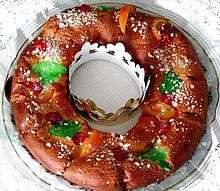
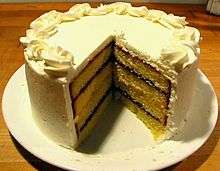


.jpg)
